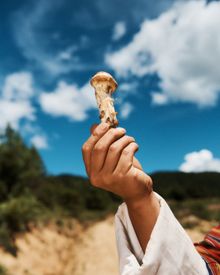 06 May 2024
06 May 2024
Tags: Bhutan, biodiversity, Environmental Conservation, Shiitake Mushrooms, Mushroom Festivals, Bhutan Believe, Sustainable Tourism, Bhutanese Cuisine

(Thimphu, Bhutan- May, 2024): Bhutan's unique environmental conditions and rich biodiversity make it a prime habitat for a diverse array of mushroom species, including over 400 that are categorized as edible, medicinal, or inedible. Notably, the Tricholoma Matsutake, locally known as Sangay Shamu, is one of Bhutan's most sought-after mushrooms, with a harvest season from July to September. In addition to the Matsutake, other popular varieties such as chanterelles, shiitake, and oyster mushrooms thrive in the region. The country also values the Cordyceps Sinensis for its esteemed medicinal properties.
Visitors have the option to find Matsutake, oyster and shitake mushrooms in markets or along roadsides, or they can join popular Matsutake festivals, such as the one in Genekha held from 15th to 16th August annually. Genekha is accessible via a 45-minute drive from Thimphu. Alternatively, Ura, Bumthang (around an 8 hour drive from Thimphu) also hosts a mushroom festival from 23rd to the 24th of August annually. These festivals feature a range of experiences and activities, including mushroom foraging, sampling delicious mushroom dishes, cultural performances by locals, and opportunities for visitors to partake in local sports.
Each mushroom variety comes with its own distinctive characteristics and peculiarities. Matsutake mushrooms, revered for their distinct flavor and taste, stand as a prized species in Bhutan, grown in the country's coniferous high-altitude forests. It is highly sought after in international markets, particularly in Japan. Chanterelles, distinguished by their golden hue and funnel shape, also thrive in Bhutan and are cherished for their unique flavor, often featured in various Bhutanese dishes. Similarly, Shitake mushrooms, renowned for their savory essence, are cultivated alongside indigenous varieties, adding diversity to culinary offerings and Oyster mushrooms, with a cap shape are wild-harvested and cultivated, contributing to Bhutan's rich mushroom culture.
Cordyceps Sinensis is also one of the species, and is valued for its medicinal properties and benefits. Foragers seek out these parasitical super mushrooms from the heads of caterpillars. The fungus is absorbed into the body of the caterpillars. Due to their rarity (as they are grown only at very high altitudes), and difficulty in harvesting they are highly treasured and sought after. They are available in local shops and make for a great gift for loved ones.
Visitors can learn more about Bhutanese mushrooms during a guided mushroom trip. Guests can book mushroom foraging or exploring tours with Bhutanese guides and tour operators. The experience offers a delightful insight into the culinary heritage of the Bhutanese. It is a wonderful opportunity to learn the basics about mushrooms and find out which ones are edible and which ones are not. Guests can also experience a one-on-one cooking class with freshly harvested mushrooms.
Mushrooms are also an integral part of Bhutanese cuisine. It plays a vital role in Bhutanese cuisine, adding texture and flavor to the traditional dishes. Guests have the opportunity to taste dishes crafted from mushrooms, with a notable dish being the Shamu Datshi, which a stew is made with mushrooms, vegetables and cheese. Guests can enjoy the dishes produced with these unique mushrooms during the mushroom festivals where locals use mushrooms to prepare a variety of delicacies or they can enjoy it in some of the Bhutan's hotels and restaurants. They use shiitake and Matsutake mushrooms to create a variety of meals, including mushroom chicken, fairy ring mushrooms with parsley and many more dishes.
Read more about mushrooms and foraging in Bhutan at this link. For more information about Bhutan's Department of Tourism, please visit www.bhutan.travel.
-ENDS-
About the Department of Tourism
The Department of Tourism of Bhutan is responsible for the development and promotion of sustainable tourism in Bhutan. It works to share the Kingdom's remarkable places, people and experiences with conscious travelers, guided by the principles of high value, low volume tourism.
Bhutan Believe
Bhutan Believe is Bhutan's national identity, which showcases an evolution and a spirit of optimism, destined to inspire pride, and spark the imagination of citizens and visitors alike.
As part of the revamped identity, the nation developed policies and plans for the country's advancement – in particular, for how it can invest in creating sustainable opportunities for its young people. Bhutan Believe goes beyond simply creating a new identity but aims to leverage the power of branding to connect Bhutan, and the stories it wants to tell, with a global audience.
Bhutan Visas and SDF
Applying for a visa (or permit) to Bhutan is simple. All visitors must have a visa and permit before traveling to Bhutan (except for tourists from India who can obtain a permit on arrival and those from Maldives and Bangladesh who can also obtain a visa on arrival). Visitors apply online for a visa or permit or via a Bhutanese Tour Operator. It takes around five days to process a visa.
All guests must pay Bhutan's Sustainable Development Fee (SDF) of USD 100 per person per night (Concessionary rates apply for children) and a non-refundable, one-off visa application fee of USD 40. Indian guests pay SDF of Nu/INR. 1,200 per person per night. The SDF funds important cultural, environmental, health and educational projects across Bhutan. More information is available at: www.bhutan.travel.
For media enquiries please contact:
Carissa Nimah, Chief Marketing Officer, Department of Tourism










